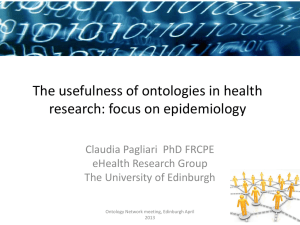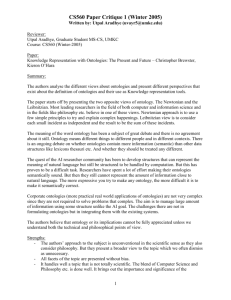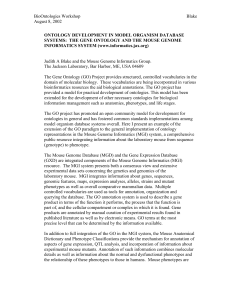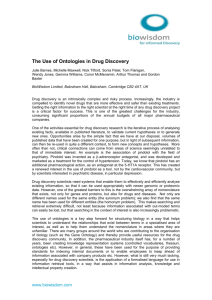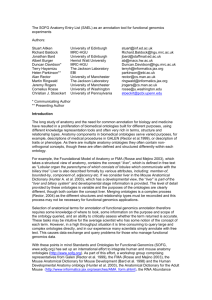doc - Bio-Ontologies 2016
advertisement
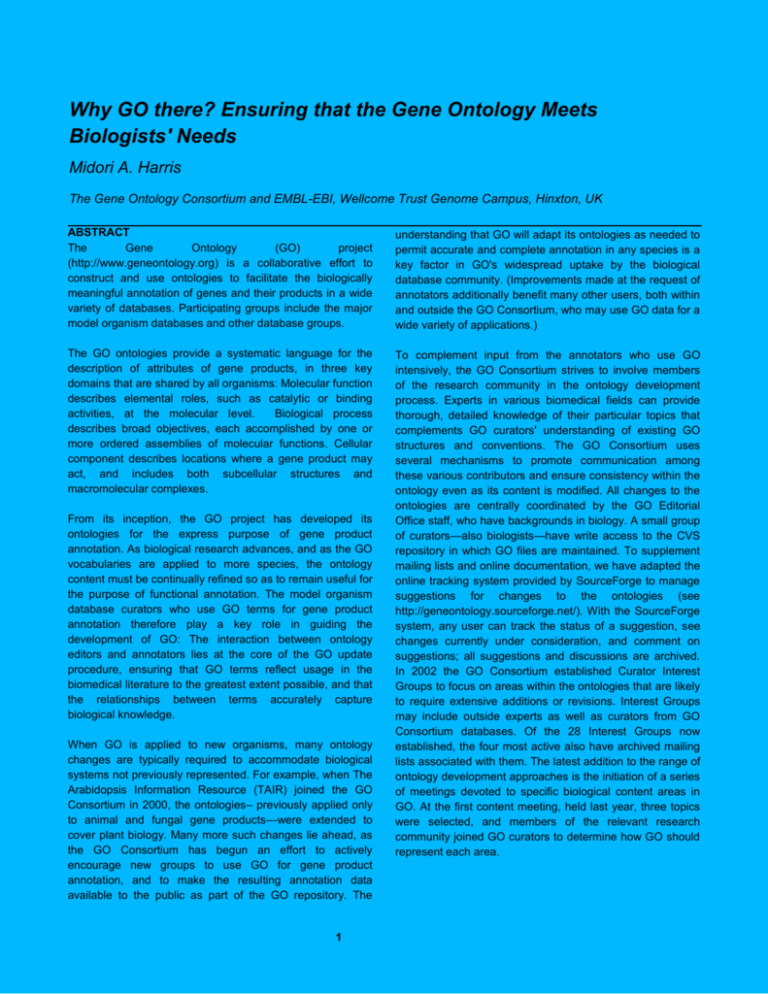
Why GO there? Ensuring that the Gene Ontology Meets Biologists' Needs Midori A. Harris The Gene Ontology Consortium and EMBL-EBI, Wellcome Trust Genome Campus, Hinxton, UK ABSTRACT The Gene Ontology (GO) project (http://www.geneontology.org) is a collaborative effort to construct and use ontologies to facilitate the biologically meaningful annotation of genes and their products in a wide variety of databases. Participating groups include the major model organism databases and other database groups. understanding that GO will adapt its ontologies as needed to permit accurate and complete annotation in any species is a key factor in GO's widespread uptake by the biological database community. (Improvements made at the request of annotators additionally benefit many other users, both within and outside the GO Consortium, who may use GO data for a wide variety of applications.) The GO ontologies provide a systematic language for the description of attributes of gene products, in three key domains that are shared by all organisms: Molecular function describes elemental roles, such as catalytic or binding activities, at the molecular level. Biological process describes broad objectives, each accomplished by one or more ordered assemblies of molecular functions. Cellular component describes locations where a gene product may act, and includes both subcellular structures and macromolecular complexes. To complement input from the annotators who use GO intensively, the GO Consortium strives to involve members of the research community in the ontology development process. Experts in various biomedical fields can provide thorough, detailed knowledge of their particular topics that complements GO curators' understanding of existing GO structures and conventions. The GO Consortium uses several mechanisms to promote communication among these various contributors and ensure consistency within the ontology even as its content is modified. All changes to the ontologies are centrally coordinated by the GO Editorial Office staff, who have backgrounds in biology. A small group of curators—also biologists—have write access to the CVS repository in which GO files are maintained. To supplement mailing lists and online documentation, we have adapted the online tracking system provided by SourceForge to manage suggestions for changes to the ontologies (see http://geneontology.sourceforge.net/). With the SourceForge system, any user can track the status of a suggestion, see changes currently under consideration, and comment on suggestions; all suggestions and discussions are archived. In 2002 the GO Consortium established Curator Interest Groups to focus on areas within the ontologies that are likely to require extensive additions or revisions. Interest Groups may include outside experts as well as curators from GO Consortium databases. Of the 28 Interest Groups now established, the four most active also have archived mailing lists associated with them. The latest addition to the range of ontology development approaches is the initiation of a series of meetings devoted to specific biological content areas in GO. At the first content meeting, held last year, three topics were selected, and members of the relevant research community joined GO curators to determine how GO should represent each area. From its inception, the GO project has developed its ontologies for the express purpose of gene product annotation. As biological research advances, and as the GO vocabularies are applied to more species, the ontology content must be continually refined so as to remain useful for the purpose of functional annotation. The model organism database curators who use GO terms for gene product annotation therefore play a key role in guiding the development of GO: The interaction between ontology editors and annotators lies at the core of the GO update procedure, ensuring that GO terms reflect usage in the biomedical literature to the greatest extent possible, and that the relationships between terms accurately capture biological knowledge. When GO is applied to new organisms, many ontology changes are typically required to accommodate biological systems not previously represented. For example, when The Arabidopsis Information Resource (TAIR) joined the GO Consortium in 2000, the ontologies– previously applied only to animal and fungal gene products—were extended to cover plant biology. Many more such changes lie ahead, as the GO Consortium has begun an effort to actively encourage new groups to use GO for gene product annotation, and to make the resulting annotation data available to the public as part of the GO repository. The 1 A different source of suggested changes is computational analysis of existing GO terms and relationships, which can identify missing relationships and missing or misplaced terms. These computational efforts, most notably the OBOL project (see http://www.fruitfly.org/~cjm/obol/), improve the logical consistency of GO, and will eventually enable GO to adopt more formal computational representations for its ontologies. Similar principles, both sociological and technical, govern the development of other ontologies in the Open Biomedical Ontologies (OBO) collection The GO Consortium welcomes feedback from the biology and bioinformatics communities on any aspect of its ontologies or their use. 2



